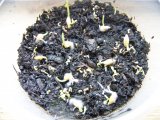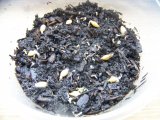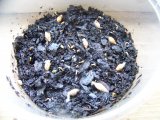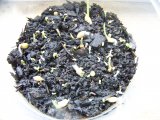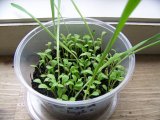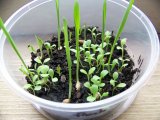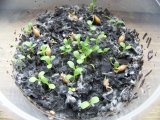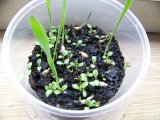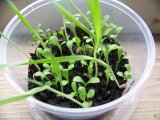Experiment 3 - Sap and Oil
Messmate sap has been prepared by mixing congealed sap from the bark of a messmate tree. It dissolves readily to form a dark red solution.
The solution prepared turns out to be very acidic (3.7), significantly more acidic than the lactic acid solutions prepared from fermenting gum leaves in water. The electrical conductivity is only 180 microsemens/metre which means that apart from the acids in the solution there is very little else in electrolytes.
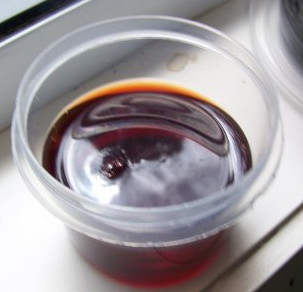
Above: solution of messmate sap.
The five pots are as follows:
1./ Old pot of Eucalyptus oil
Originally contained 1ml of Eucalyptus oil is mixed with 80 grams of potting mix. It was used in Experiment 2, and now has the seedlings removed to be re-used again to see if it still inhibits growth.
2./ Fresh Eucalyptus Oil Mix
A fresh version of the above containing 1ml of Eucalyptus oil with 80 grams of potting mix, and watered with 75ml of clean tank water.
3./ Fresh Eucalyptus oil and dissolved messmate sap
1ml of fresh eucalyptus oil in 80 grams of potting mix, watered with the messmate sap solution described above.
4./ Messmate sap mx
80 grams of potting mix watered with the highly acidic messmate sap solution as described above.
5./ Control
This pot is 80 grams of plain potting mix watered with 75mls of clean tank water.
figure 1. Chicory and Barley seeds after 4 days
Already after 4 days the experiment appears to confirm my suspicions from the previous experiments. The original pot containing eucalyptus oil had detoxified over the course of the previous experiment.
We are seeing the same growth inhibition in the pots containing fresh oil, as well as the inhibition in the sap-only mix which would be expected from the high acidity of this solution. However very early on we see some indication that the sap solution - while acidic, is not stopping barley seeds from germinating compared to those containing eucalyptus oil.
white mould is redeveloping in the re-used oil pot. All other pots apart from the control are showing a little bit of white-mould growth.
figure 2. Chicory and Barley seeds after 10 days
After 10 days it is clear that the old pot containing oil is completely detoxified and performing as well as the control. The pot of fresh oil is now showing signs of also being detoxified, and the pot containing sap water is producing healthy looking seedlings even if delayed in growth.
Root development in the sap-only pot is however reduced - the roots have not reached the base of the pot, while the pot that contains fresh oil is showing roots as the base. Given that the above ground growth in these two pots is the same, this is a significant difference. It should be recalled that root-development was found to be less in the oiled pots in the previous experiment - so it seems sap has even more root inhibition properties than oil.
The standout finding so far is that oil combined with sap has a significant deleterious effect on seedling growth. The barley seedlings seem to have been totally thwarted, and the pot is covered in a white mould similar to the moulds seen earlier in all the other pots, but these have cleared up.
The solution prepared turns out to be very acidic (3.7), significantly more acidic than the lactic acid solutions prepared from fermenting gum leaves in water. The electrical conductivity is only 180 microsemens/metre which means that apart from the acids in the solution there is very little else in electrolytes.

Above: solution of messmate sap.
The five pots are as follows:
1./ Old pot of Eucalyptus oil
Originally contained 1ml of Eucalyptus oil is mixed with 80 grams of potting mix. It was used in Experiment 2, and now has the seedlings removed to be re-used again to see if it still inhibits growth.
2./ Fresh Eucalyptus Oil Mix
A fresh version of the above containing 1ml of Eucalyptus oil with 80 grams of potting mix, and watered with 75ml of clean tank water.
3./ Fresh Eucalyptus oil and dissolved messmate sap
1ml of fresh eucalyptus oil in 80 grams of potting mix, watered with the messmate sap solution described above.
4./ Messmate sap mx
80 grams of potting mix watered with the highly acidic messmate sap solution as described above.
5./ Control
This pot is 80 grams of plain potting mix watered with 75mls of clean tank water.
figure 1. Chicory and Barley seeds after 4 days
Already after 4 days the experiment appears to confirm my suspicions from the previous experiments. The original pot containing eucalyptus oil had detoxified over the course of the previous experiment.
We are seeing the same growth inhibition in the pots containing fresh oil, as well as the inhibition in the sap-only mix which would be expected from the high acidity of this solution. However very early on we see some indication that the sap solution - while acidic, is not stopping barley seeds from germinating compared to those containing eucalyptus oil.
white mould is redeveloping in the re-used oil pot. All other pots apart from the control are showing a little bit of white-mould growth.
figure 2. Chicory and Barley seeds after 10 days
After 10 days it is clear that the old pot containing oil is completely detoxified and performing as well as the control. The pot of fresh oil is now showing signs of also being detoxified, and the pot containing sap water is producing healthy looking seedlings even if delayed in growth.
Root development in the sap-only pot is however reduced - the roots have not reached the base of the pot, while the pot that contains fresh oil is showing roots as the base. Given that the above ground growth in these two pots is the same, this is a significant difference. It should be recalled that root-development was found to be less in the oiled pots in the previous experiment - so it seems sap has even more root inhibition properties than oil.
The standout finding so far is that oil combined with sap has a significant deleterious effect on seedling growth. The barley seedlings seem to have been totally thwarted, and the pot is covered in a white mould similar to the moulds seen earlier in all the other pots, but these have cleared up.

